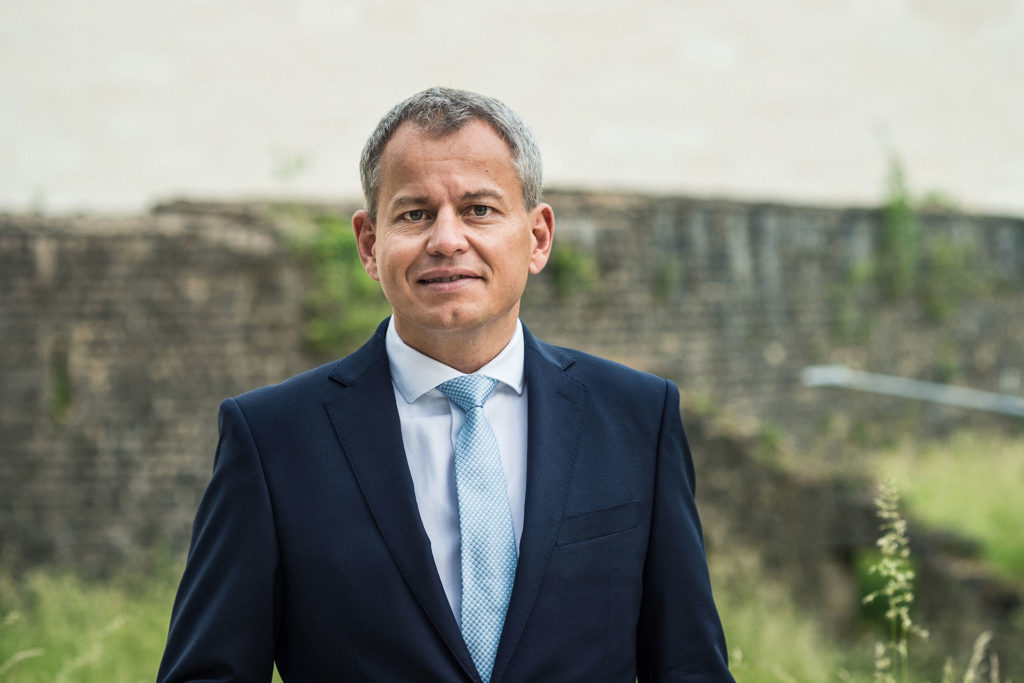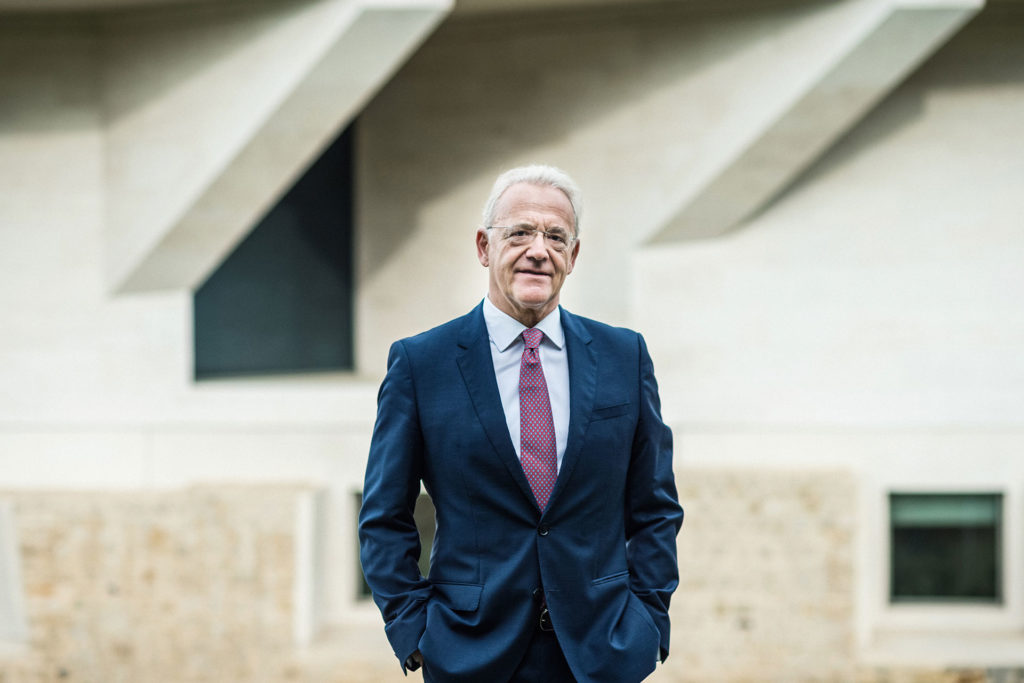Financing is the lifeblood of international business projects and transactions. since the development of the Eurobond market in the 1960s, Luxembourg has established itself as an international hub for bilateral and syndicated loans in the Eurozone and beyond. corporate banks in Luxembourg constitute the beating heart of cross-border finance: their expert teams coordinate with clients and banking partners worldwide to support business with a full range of services.

Anne-Sophie Weyland
SYNDICATED AND BILATERAL FINANCE
The majority of corporate loans and financing solutions in the Grand Duchy are extended on a cross-border basis.
Anne-Sophie Weyland, Director Corporate Banking at BGL BNP Paribas Luxembourg, explains: “Our credit expert team handles or igination, credit analysis, credit structuring, decision and execution. In recent years, our bank has played a central role in a variety of large international financing deals, be they bank loans or capital market transactions, from the analysis to the arrangement of the structure and the syndication, the whole process was executed out of the bank in Luxembourg.”
Moreover, in the case of syndicated loans, one bank is usually appointed as the agency bank to manage the loan on behalf of the syndicate members.

In recent years, our bank has played a central role in a variety of large international financing deals, be they bank loans or capital market transactions, from the analysis to the arrangement of the structure and the syndication, the whole process was executed out of the bank in Luxembourg.
This work can be extensive and complex. Syndicated loans often include dozens of banks from multiple countries in different time zones. Several hundred parties can be involved. Information flow, processes and payments need to be organised efficiently.
“During the life of the loan (typically 5-10 years or more) many things can happen. The borrower or a lender may become distressed or two banks that are part of a syndicate may merge together causing a change in risk exposure. Any such event can affect the multipartite process, requiring coordination by the agency bank,” explains Frank Krings, CEO of Deutsche Bank Luxembourg.

Frank Krings
Whereas 20 years ago the documentation for a typical loan might be 20 pages, the same document today can easily run to over a 1,000 pages.
“Luxembourg is perfectly equipped to manage this level of complexity,” he adds. For example, earlier this year, Heidelberg-Cement signed a new 3 billion EUR syndicated credit facility. Twenty banks were mandated as bookrunners and lead arrangers in this transaction. Deutsche Bank Luxembourg acted as lender, documentation and facility agent. “You may install IT anywhere, but not necessarily domain experts. The team here has extensive experience and expertise in international commercial matters on the legal, economic and transactional front. This is a key reason why we have this excellence centre in Luxembourg. Day in, day out, the teams breathe international,” underlines Krings.

This is a key reason why we have this excellence centre in Luxembourg. Day in, day out, the teams breathe international.

Sijia Duan
CONNECTING WITH CHINA
Chinese banks in Luxembourg are a good example of international banks that operate predominantly in corporate banking (trade and project financing and syndicated loans). In addition to corporate banking services, these banks have expanded into capital market activities in Europe as well as asset and wealth management, thereby serving as a bridge connecting Europe and China.
During the last two decades, Chinese investors have consolidated their economic presence in the EU through greenfield investments, mergers and acquisitions.

The aim of the HSBC China Desk is to assist Chinese corporates to establish their holding company, navigate through local regulations and coordinate with various teams across jurisdictions to make sure the process is smooth and successful.
Chinese banks have, as a result, sought a base in Europe through which they can serve such clients, helping Chinese customers invest into Europe as well as European clients looking to invest in China. Seven major Chinese banks have chosen Luxembourg as their continental Europe an hub. In 2016, 38.5% of the Chinese banks’ business in Luxembourg was lending-related (trade and project financing, as well as syndicated loans). Furthermore, Luxembourg’s expertise in cross-border financing projects is particularly useful for the “Belt and Road” initiative (BRI), involving China underwriting billions of dollars of infrastructure investment in 68 countries along the old Silk Road, linking it with Europe.
HSBC, a global bank with roots in Asia, is currently involved in more than 100 BRI projects globally. HSBC has five China Desks located in Europe.
“The Luxembourg China Desk was established in early 2017 in order to work closely with local Chinese banks and corporate subsidiaries. Chinese firms investing overseas, especially in Europe, are quite often required to set up a holding structure in Luxembourg. The aim of the HSBC China Desk is to assist Chinese corporates to establish their holding company, navigate through local regulations and coordinate with various teams across jurisdictions to make sure the process is smooth and successful,” explains Sijia Duan who manages the China Desk at HSBC Luxembourg.
TRADE FINANCE
BRI is just one of the recent international programs that are encouraging growth in trade. Today’s world is a more connected one and with more connections comes a greater amount of financial uncertainty. Overseas markets hold significant potential, but doing business abroad can present new difficulties.
Companies moving into foreign markets may face regulatory, political and financial challenges, including logistical hurdles, protectionism, currency risk, etc. Banks in Luxembourg can smooth the barriers to international trade and assist companies in international trade transactions, including lending and issuing letters of credit, as well as factoring, export credit and insurance.

One of the most important deals Intesa Sanpaolo Bank Luxembourg arranged recently was a 14.5-year credit line facility with Yamal LNG, a liquefied natural gas plant in Russia, for the total amount of 750 million EUR.

Ferdinando Angeletti, CEO of Intesa Sanpaolo Bank Luxembourg, explains how the activities of the banks have evolved:
“During the last years, as part of the strategic development plan of the bank, we launched a Structured Export Finance Desk. This department is focused in structuring, arranging and lending activities in the Commodity Financing and Export Finance ECA’s backed loans areas. One of the most important deals Intesa Sanpaolo Bank Luxembourg arranged recently was a 14.5-year credit line facility with Yamal LNG, a liquefied natural gas plant in Russia, for the total amount of 750 million EUR.”

Véronique de La Bachelerie
CAPITAL RAISING FOR CIRCULAR ECONOMY COMPANIES
When financing a major investment or implementing large international projects, it may be necessary to use a tailored structure because a simple loan or other type of conventional financial instrument will not satisfy the needs. Structured finance is typically employed for companies requiring substantial financing deals that encompass long production and credit extension periods. It can benefit them by reducing funding costs, and can help to diversify risk by spreading it across different asset classes, geographies, industries, instruments, and credit risks. Banks in Luxembourg have wide experience in this area, combining technical knowledge and cross-border expertise to meet the specific needs of treasury and finance centres. Structured finance can also be used to finance circular economy companies. With this in mind, Société Générale, for example, makes full use of the toolbox of structures available in Luxembourg including securitisation issues, debt issues or infrastructure funds such as the ELTIF (European Long-Term Investment Fund).

We can mobilise teams in the equity and bond markets as well as provide advice and support to the circular economy company both at the structuring stage and in placing the deal with investors.
The principal difference between a traditional company and circular economy company is its financial cycle. The economic model of a traditional manufacturing company is linear, whereas the economic model of a circular economy company is based on the principle of extending the life of a good. In its business model, a circular economy company has to address two needs: a need for increased long-term financing to cover the additional Research & Development costs (traditionally capitalised on their balance sheet) as well as the residual value of leased assets; and a need for working capital to replace the structural income gap caused by moving away from the up-front sale of products to a rental model.
Véronique de La Bachelerie, CEO of Societe Generale Bank & Trust Luxembourg, explains:
“To satisfy the first need, we can mobilise teams in the equity and bond markets as well as provide advice and support to the circular economy company both at the structuring stage and in placing the deal with investors, whom it is their responsibility to identify. Alternatively, the debt can be bundled into a structured vehicle with a view to onward distribution. Such a distribution might take the form of a syndication, a third party sub-participation or any other form of repackaging.”
To finance its working capital requirements, the circular economy company may use securitisation, factoring or any other asset-backed financing strategy. All these techniques have been successfully tried and tested in the past. “Moreover, in the context of the EU’s STS (Simple, Transparent, Standardised) regulation, these structures are likely to become popular with investors who will appreciate the underlying risk diversification and clarity of the product. If its business model is viable, the circular economy company should be able to raise cash with confidence and at a moderate cost profile in relation to the diversification of the risk taken by the investor,” concludes Véronique de La Bachelerie



